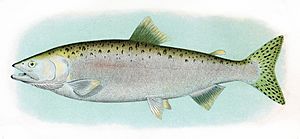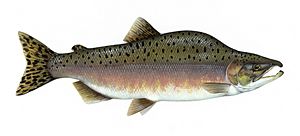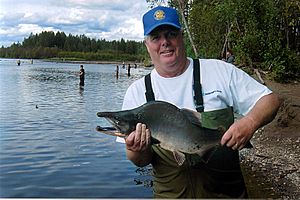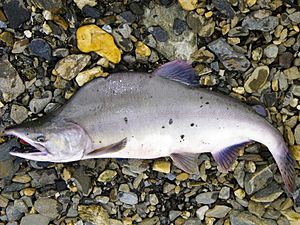Pink salmon facts for kids
Quick facts for kids Pink salmon |
|
|---|---|
 |
|
| Male ocean phase pink salmon | |
| Conservation status | |
| Scientific classification | |
| Genus: |
Oncorhynchus
|
| Species: |
gorbuscha
|

The Pink salmon, also known as the humpback salmon, is a type of fish that lives in both fresh and salt water. Its scientific name is Oncorhynchus gorbuscha. This fish belongs to the Salmonidae family, which includes all salmon and trout.
Pink salmon are the smallest and most common of the seven main types of Pacific salmon. Their scientific name, gorbuscha, comes from the Russian word gorbúša, which means "humpie." This nickname refers to the large hump that male pink salmon develop on their backs when they are ready to lay eggs.
Contents
What Do Pink Salmon Look Like?
When pink salmon live in the ocean, they are bright silver. But when they swim back to rivers to lay their eggs, their color changes. Their backs become pale grey, and their bellies turn yellowish-white. Some might even become a dull green color.
Like all salmon, they have a special small fin called an adipose fin, located behind their main back fin. Pink salmon have a white mouth with black gums and no teeth on their tongue. They also have large, oval-shaped black spots on their back and a V-shaped tail.
Male pink salmon are famous for growing a big hump on their back during their journey to lay eggs. This is why they are often called "humpies." On average, pink salmon weigh about 4.8 pounds (2.2 kg). The biggest one ever recorded was 30 inches (76 cm) long and weighed 15 pounds (6.8 kg).
Where Do Pink Salmon Live?
Pink salmon naturally live in the Pacific Ocean and Arctic Ocean along the coasts and in rivers. In North America, you can find them from the Mackenzie River in Canada down to rivers in California. In Asia, they live from the Lena River in Siberia to Korea and Japan.
Pink salmon were also brought to the Great Lakes in North America. The first time this happened was in 1956, when about 100 salmon escaped into Lake Superior. Later, more young salmon were released there. These fish adapted to live their whole lives in freshwater, swimming into rivers to lay eggs. By 1979, pink salmon had spread throughout all the Great Lakes.
They have also been introduced to rivers in Iran and parts of Europe, like Russia's White Sea and Barents Sea. Sometimes, these fish swim into rivers in Norway, Sweden, Ireland, Great Britain, and Iceland. In 2017, many more pink salmon than usual were seen in Scottish rivers. By 2021, they were even reported in the Akerselva river in downtown Oslo, Norway.
Pink Salmon Life and Habitat
Habitat and Temperature
Pink salmon prefer cold water. They like temperatures between 5.6 and 14.6 degrees Celsius (about 42 to 58 degrees Fahrenheit). Their ideal temperature is around 10.1 degrees Celsius (50 degrees Fahrenheit). They cannot survive in water hotter than 25.8 degrees Celsius (78 degrees Fahrenheit).
Reproduction and Life Cycle
Pink salmon have a very strict two-year life cycle. This means that salmon born in an odd-numbered year (like 2023) will only have babies in another odd-numbered year (like 2025). They do not mix with salmon born in even-numbered years.
Adult pink salmon swim from the ocean back to the same rivers where they were born. This journey happens between late June and mid-October. The female salmon uses her tail to dig a nest, called a redd, in the gravel at the bottom of the stream. She then lays her eggs in this nest.
As she lays the eggs, one or more male salmon come close to fertilize them. After the eggs are laid, the female covers them with gravel using her tail. A female salmon can lay between 1,000 and 2,000 eggs in her nest. She guards her nest until she dies, which usually happens within a few days of laying eggs.
The eggs hatch between December and February, depending on how warm the water is. The tiny baby salmon, called juveniles, come out of the gravel in March and April. They quickly swim downstream to estuaries (where rivers meet the sea). They become adults and are ready to have their own babies when they are two years old.
What Do Pink Salmon Eat?
When pink salmon are young and live in freshwater, they eat small water bugs and tiny floating animals called zooplankton. Once they move to the ocean, they eat different types of plankton, small sea creatures, and tiny fish. Adult pink salmon stop eating when they return to freshwater to lay their eggs.
Who Eats Pink Salmon?
Many animals eat pink salmon at different stages of their lives. When they are eggs or tiny fish in rivers, small fish, birds, and mammals might eat them. In the ocean, bigger fish, seabirds, and marine mammals like seals eat them.
When adult salmon die after laying their eggs, their bodies provide important food for other animals and plants in the river. For example, bears often catch salmon and carry them away from the water into forests. This helps spread nutrients from the salmon's body to the plants and trees. The dead salmon also break down quickly, feeding tiny water insects. This extra food can help other types of salmon grow bigger in the same rivers.
Conservation Status
The conservation status of pink salmon varies by location. In California, they are considered "critically imperiled," meaning they are in great danger. In Washington, they are "imperiled," which means they are also at risk. However, in Alaska and British Columbia, their populations are considered "secure" and healthy. No pink salmon groups are currently listed as endangered under the Endangered Species Act.
Fishing and Uses

Pink salmon are very important for fishing industries in the northern Pacific Ocean. In 2010, about 260 million pink salmon were caught, weighing about 400,000 tonnes. Most of these fish were caught by Russia (140 million) and the USA (107 million, mostly in Alaska). Pink salmon make up about 69% of all salmon caught in Russia.
In the past, fish traps were used to catch pink salmon for canning and salting. But in Alaska, fish traps were banned in 1959. Today, most pink salmon are caught using large nets like purse seines, drift nets, or gillnets. After a decline in the 1940s and 1950s, pink salmon populations have grown a lot since the mid-1970s and are now at record high numbers.
Many pink salmon are also raised in special hatcheries to help boost their numbers, especially in Alaska. Pink salmon are not usually raised in fish farms. The fish are often canned, smoked, or salted for food. Their eggs, called roe, are also collected to make caviar, which is a valuable food in Asia.
See also
 In Spanish: Salmón rosado para niños
In Spanish: Salmón rosado para niños





